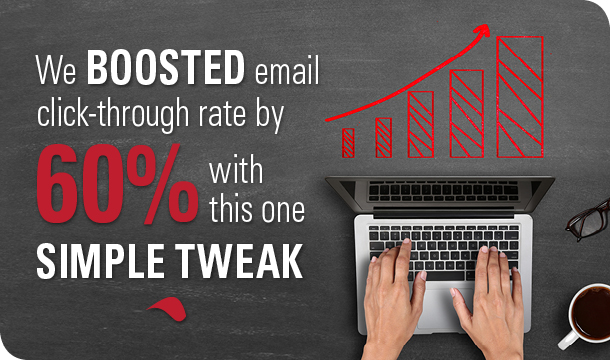We boosted email click-through rate by 60 percent with this one simple tweak
Email remains one of the most reliable and consistent vehicles for B2B marketers today. In fact, people sent more of it in 2018 than ever before, and statistics continue to show that email marketing delivers excellent ROI.
I don’t care what the haters say. When done right, email marketing works.
If you’re among the many marketers who leverage email, you’re familiar with the never-ending quest to streamline your contact lists, draft the perfect subject lines and increase your click-through rate (CTR). We can often be slaves to these analytics, looking for any little way we can move the needle. (After all, these numbers are a direct and unapologetic reflection of our efforts, right?)
When it comes to optimizing your email marketing, there are countless variables in play. I get that. I want to share one little success we had, with the hope that perhaps it can help you, too.
Suggest relevant content, not just the latest content
Okay, this may sound obvious, but you should be delivering content that your audience wants. While this mindset is often a part of developing a high-level marketing strategy, do you think about it when you’re in the weeds, formatting your email sends?
We maintain a weekly blog for one of our clients, and we manage the email marketing program that promotes the blog’s content. A weekly email to subscribers promotes that week’s new post and suggests three other blog posts below it.
Traditionally, that section was titled “Recent Posts” and featured the three most recent blog posts that had been published prior to that week.
Our idea: What if we changed “Recent Posts” to “Related Posts” and featured three posts that were similar to that week’s featured topic?
It may seem like a small tweak, but the results were dramatic. After making the change, email click-through rates increased more than 60 percent from 6 percent to 9.8 percent.
The power of a relevant recommendation
The outcome isn’t entirely surprising, because this isn’t a new concept. Consider the success of companies like Amazon, Netflix and Spotify: They curate content and make recommendations based on your preferences and previous behavior. The same is true here: Give your readers more of what they want.

If a subscriber has opened an email (because the subject line interested them), then you already have a relatively captive audience. It would then make sense to suggest additional content similar to the topic the recipient already engaged with, thus increasing clicks.
And it doesn’t always have to be blog posts. Perhaps there’s a relevant e-book, white paper, case study or video you could include in an email to a specific contact list. Delivering useful, targeted content to an engaged audience will generally yield more clicks.
A caveat about click-through rates: They can vary drastically by the type of email you’re sending out. In general, newsletters have higher click-through rates than promotional emails, and transactional ones tend to have the highest response rate. Be sure to factor that into your evaluation.
Consider how you can cross-promote related content in all of your email sends, and keep in mind that the newest information on any ol’ topic isn’t always the most relevant or useful for a particular audience.
Less can be more: Email the right people
Since we’re talking about email optimization and metrics, here’s one more tidbit: Don’t blast everyone and their mother with every single one of your emails.
It’s so, so important to segment your email lists so that you’re tailoring your content to the audience that receives it. As a marketer, you already know that the right person getting the right message at the right time can make all the difference. Email is no different.
Also, don’t only consider who is on those segmented lists, but look at how they’re behaving.
When we were tinkering with the email strategy for the client I mentioned above, we analyzed the engagement of the subscribers receiving those emails. When we removed low-engagement contacts (who hadn’t so much as opened an email in ages) from our mailing list, click-through rates shot up even more.
Yes, we were sending email to fewer people, but that audience was more engaged. Plus, it improved our client’s sender reputation.
The recipients who have clicked “move to junk” every time you’ve sent an email in the last year aren’t going to miss you. Targeting a strategically compiled list is always better than casting the widest net possible and crossing your fingers.
The list of potential tweaks to optimize email marketing is long, and a lot of it depends on your particular business, industry, goals and content. Wondering how you can optimize (or jump-start) your email marketing strategy? Send me an email at steven@rep-ink.com, and let’s chat!









